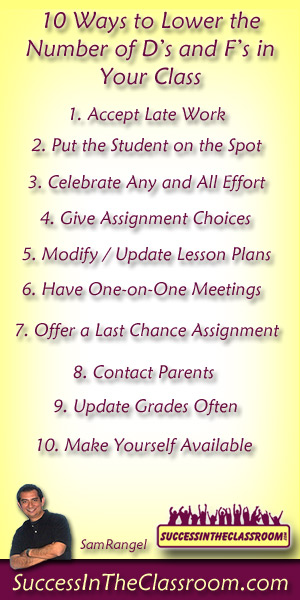Hello again. It’s been a while since I’ve added a post to this site. It’s been a busy year.
As a new teacher, it’s hard enough just making lesson plans, delivering the lesson, and maintaining classroom management.
At the end of the grading period, however, it can be disheartening when you see that many of your students are not being successful in your class and are receiving D’s and F’s.
Having a high number of D’s and F’s is not a good way to impress your administration, especially if you are new to teaching.
In this post, I’d like to share some strategies to lower the number of these negative grades.
When I was teaching, (I’ve been in administration for the last two years), I felt that if a student failed my class, it was because I had failed in doing my job as a teacher. I know there are some teachers who will say, “If the student doesn’t want to try, it’s not my fault. You can’t make them want to learn.” I’ve heard this often. I’ve even said it myself.
I wholeheartedly disagree.
Did students fail my class? Yes, but it was only after I had tried everything I could to reach those students. I believe I could have been able to get each of those students to be successful in my class, had I had a little more time. I needed more year.
I believe that if a student is failing a class, the blame falls primarily on the teacher.
(Pause while the shouts and jeers die down)
I know many veteran teachers will say, “You can’t save them all. They choose to fail.” I know. I’ve given such advice.
If we believe this, we’re saying that we are leaving the education of these students in their own hands. We are saying that the students have to be responsible enough to do what is necessary to get an education, and it’s up to them if they want to accept it.
I’m ashamed to say that I’ve made these statements. I’ve even taught student teachers to see it this way.
I was wrong.
These are kids. They need us.
Our students should not be failing our classes. If they are, then we have to see ourselves as the ones to blame.
Do you want to lower your D and F numbers?
Here are 10 Ways to Lower the Number of D’s and F’s in Your Class
1. Accept Late Work
I know that this might be tough for some teachers to do. You want to show them how to be responsible, but as I shared in a recent post, “Right now, the positive effect of a passing grade in Language Arts or History or Science or Math will do more to make that student successful than the lesson they’ll learn about the importance of due dates.” It’s OK to take off points for being late, but even 50% is better than a 0.
2. Put the Student on the Spot
When you’re collecting homework, and Johnny doesn’t have his homework, ask him why? Yes, stop the class, and ask him why. Don’t move on until you receive an answer. Don’t start lecturing. Don’t humiliate or embarrass him. Just ask him why. He will probably say something like, “I forgot it” or “I didn’t understand it” or “I don’t know.” Then you ask the second question: “When am I going to get it?” He will most likely say, “Tomorrow.” You respond by saying, “OK, I want it tomorrow. I’m going to take some points away for being late, but make sure you bring it in tomorrow, OK?” Then move on. This little uncomfortable moment will serve not only to teach Johnny to do his homework, but it also sends a message to the rest of the class that homework is important.
3. Celebrate Any and All Effort
After a while, you’ll get to know who the probable D and F students will be. Make sure you reward their efforts, no matter how small. If Johnny turns in his homework only half completed, say something like, “Johnny, you did your homework. Nice job. Next time, I need you to complete all of it. Can you do that?” Always see the glass half full.
4. Give Assignment Choices
Many times, teachers will make an assignment that all students have to do. Most students will complete the assignment, but those students who need a little more motivation, will find that one assignment less than interesting, and will probably not do it. By offering different options for that assignment, and allowing that student to choose his/her own way of completing the assignment, the chances are greater that the assignment will be completed. You want to see if the student understands the concept, and there are several ways that a student can demonstrate this – poster, book report, video, interview script, oral report, PowerPoint, skit, etc.
5. Modify / Update Lesson Plans
I found that the lessons that were successful in previous years, weren’t always successful the next year. It’s OK to update lessons to better reach your current students. Book reports were fine ten years ago, but now with technology, book reports are “old school,” and you’ll get more students spending time on your assignments if you take advantage of technology. Imagine having a student create a video on what they learned about a book, then post it on YouTube?
After about two weeks, take a look at your gradebook, and highlight those students who are earning D’s and F’s. Make time to have a one-on-one, face-to-face meeting with him/her. Show him/her their grade, and find out what is going on. This meeting is not a finger-pointing session where you give them their in-danger-of-failing speech. This meeting is to communicate with that student how he/she can improve their grade. It’s also a time where you demonstrate your concern for the student. Have these meetings every two-three weeks. The student’s final grade should never be a surprise. On a side note, if after two or three weeks, you have over 15% of your class receiving D’s or F’s, it’s time to re-evaluate your lesson planning. Sorry.
7. Offer a Last Chance Assignment
At the end of the grading period, students should already know if they are in danger of failing. Let them know that there is still a chance to get a C if they complete a final assignment. Make it a tough assignment that will make them spend some time on. Always offer hope. It’s important that you not give students a date when no more work will be accepted, unless it’s the end of the trimester or semester. I say this, because I know that some teachers will stop accepting work a week before grades are due, to allow them to use that week to “shut down.” There is always time for students to help themselves.
8. Contact Parents
In the district where I work, the minimum requirement that a teacher has to notify parents of a student who is in danger of failing is a notice home about six weeks into the grading period. That’s all. Unfortunately, many teachers are content with complying with the minimum. What happens is that at the end of the trimester or semester, parents get a report card that has D’s and F’s, and they get upset at the teacher for not letting them know earlier. Trust me; most parents want to know if their student is not being successful. They want to help. Teachers need to make the call home to alert parents to their student’s lack of progress. I used to have the student make the call. “Mom, I’m at school. My teacher is here with me. He wanted me to call you to let you know that I’m in danger of failing his class.” Now that’s powerful. Now with email, a teacher can easily let parents know how their child is doing.
9. Update Grades Often
This is a tough one for some teachers. It requires teachers to grade assignments in a timely manner. If the grades are not updated often, it will allow students to get too far behind to help themselves. Having the grades updated more frequently will also allow the teacher to better monitor those students who may start slacking.
10. Make Yourself Available
Can students come see you before school, during lunch, or after school for help or to catch up on homework that didn’t get done the night before? I know that teachers are not required to stay beyond their contract time at school, but the best teachers do. They sacrifice their time to make sure their students are succeeding. Many students who need to stay after school to get their work done or to get extra help don’t take advantage of your extra help. This is where you can communicate with parents, and have them require that they stay with you after school in a sort of “Academic Detention.” Don’t call it “Academic Detention.” That sounds negative. Call it something like “Catch Up Class” or “Success Club” or something positive. I know it’s extra time on your part, but not only will you be able to help a student improve his/her grades, but it’s a good way to connect with a student or a group of students who might otherwise be invisible.
There you have it: 10 Ways to Lower the Number of D’s and F’s in Your Class
I was talking to one of my friends who just happens to be a principal in my district, and he was mentioning that he keeps track of the number of D’s and F’s for each teacher. He shared with me that this number is considered when determining how the teacher will be evaluated.
I hope that when it comes time to sit down with your evaluating administrator, you will be able to proudly open your gradebook and show him/her how successful your students are doing, and if there are students who are receiving D’s and F’s, you’ll be able to document all the strategies and interventions you have used with them.
Like I said earlier, I believe that if a student failed my class, the failure was mine as a teacher.
I welcome any comments. I would like to hear opposing views. I know they are out there. : )
Until next time,
Here’s to your Success In Your Classroom!
Thanks,
Sam





I’m pulled, I’ve come across students who will make up answers verbally and in writing because they have noticed most teachers will just “fill in the blank, students who have lied for years to their parents about doing their home or saying they don’t understand (parent worked exceedingly long hours) and 8/9th graders so accustomed to modified work they lack motivation and drive. So many students are not able to read in 6th grade because of some of the above suggestions.
I understand what you are suggesting and at times use the same strategies, however it appears a great deal depends upon parental involvement, and cultural environment. Forgive me for saying this, but I believe modifying schoolwork without eventually eliminating the modification(s) may possibly be the reason so many students perform so poorly in so many academic areas.
Hello Vebacee. Thank you for your comment. I agree that environment and parent involvement are critical elements in a student’s education. I don’t know if I wasn’t clear enough, but I didn’t want to say that teachers should modify the lesson to accommodate a student’s low motivation. What I meant was that a teacher has to be open to new ways of teaching the same lesson. I don’t believe in “dumbing down” a lesson. I do believe that a lesson that worked in earlier years may need some revamping to reach a new group of students – students who might not have the support of the parents or are growing up in a different environment. Sorry if there was any confusion.Thank you again for your comment. Sam
Hello,
Thank you for your post, it was encouraging and disheartening at the same time for me. It was my first year teaching and I did use many of the strategies that you posted. And yes, it felt like a personal failure when my students were failing. Many did well, but many did not – and with only 15 students in the class, any more than 2 was over 15%. I agree that one of the biggest factors was needing more time, especially since the ones that did the worst had excessive absences and therefore shortened the time I had with them even more. At times I felt that maybe I was being to hard on them, that I should have modified the lessons, but then they would not have been working at grade level. I used a few alternative assignment products such as a power point, poem, play, but none of my students took advantage of them. They all chose the traditional methods. It was as if they were unaccustomed to doing anything creative which I know to be false, at least for the older ones as I know who their teacher was last year! I contacted parents often and after the first quarter, began sending home weekly progress reports. No one was surprised by any report card grades, good or bad. The only thing I didn’t do was #3, if an assignment was incomplete, I didn’t ‘celebrate’ that effort. My feedback was not a smiley face. And as for modifying lessons, I tried many approaches, but these were first drafts as I didn’t have previous years plans to go on. It’s frustrating, because I do feel personally responsible yet I did try nearly all of the 10 strategies and only 4 honor roll students. Many squeaked by with C’s because I gave so much extra credit at the end. Any advice for next year?
Hello CJ,
Thank you for your comment. Believe it or not, your comment was very encouraging for me. I read the words of a teacher who is so concerned about her students that she is getting down on herself for their struggles. Believe me, I’ve known teachers who wouldn’t have even cared at all. Keep doing what you’re doing. Keep looking for new ways to teach an old subject. Find out what the students are interested in, and use that in your lesson. If your unmotivated student likes soccer, try and incorporate soccer into your lessons. Making that connection with an unmotivated student will make it easier to get him/her to try. Don’t be discouraged. You might not be able to save all of them, but the connections you make and the impact you will have on their lives will carry on in them long after they’ve left your class, even if they don’t get the A. Thank you again for your comment. Hang in there. The first year is always the toughest. : ) Sam